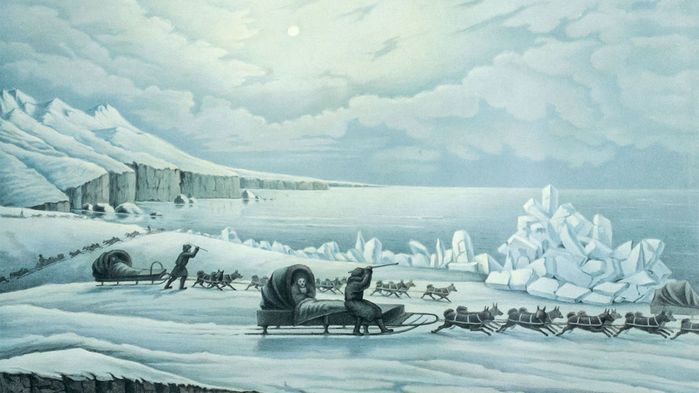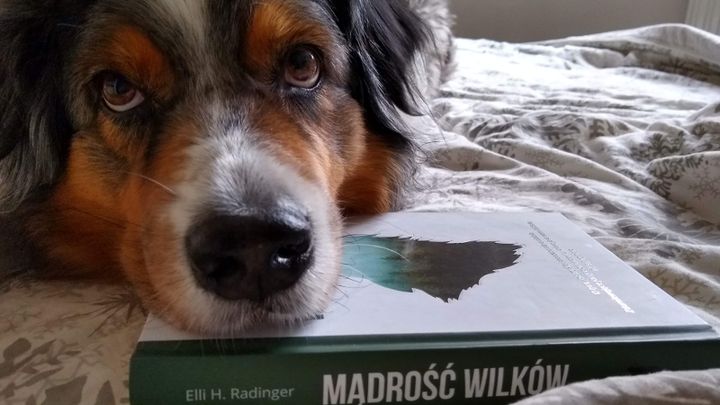Study reveals the Inuit sled dogs' specific heritage
Siberian discovery confirmed the earliest evidence for dog breeding taking place on remote Zhokhov Island. New study, concerning the North American Arctic area, finds Inuit sledge dogs unique and specialised to help them to thrive.

According to Coppinger's theory, pre-dog domestication process itself ran based on natural selection: Most confident, social pre-dogs got used to living close to human settlements, eating garbage and bringing up safely their offspring (fire deterred other predators, like wild cats living and hunting alone). In exchange, humans gained warning about danger and deterring potential intruders (by mature pre-dogs). Relatively smaller/weaker individuals adapted to a diet containing leftovers (low quality, less protein, less calories), then gave up their predation and hunting/living in packs habits for half-solitary scavenging. Domestic dog became the first domesticated animal - entirely and certainly the first predator put through that human-focused process.
In association with their utility, dogs were generally divided into
- assisting humans during hunting (nomadic hunter-gatherers) - sight-hounds, scent-hounds
- dedicated pastoral types (sedentary farming, agriculture) - guarding dogs, herding dogs.
Sled dogs assisted newcomers during Early human migrations - they were irreplaceable in transportation.
Siberian archaeozoological discovery previously confirmed the earliest evidence for dog breeding taking place on the remote Zhokhov Island, where Paleo-Arctic dwellers were supposed to hunt polar bears, then pursued reindeer to survive frigid temperatures on vast territory in animal-skin tents. Researchers suggest that discovered remains belong to dogs bred for pulling a sled (one of them could be a wolf-dog hybrid). A comparison of their skulls to wolf skulls and Siberian Husky's ones coming from that region, proved its Canis familiaris species affinity.
Current study hypothesises about the Inuit dogs being intentionally maintained to keep/enhance the unique features instead of local dogs being adopted in course of their migration across the continent. Siberian Inuit are descendants of migrants who crossed Beringia during the Paleolithic, expanding their indigenous Asian culture to Greenland, subarctic Eastern Canada and the North American Arctic regions. Those Paleo-Arctic dwellers supposed to hunt sea mammals, and wandered huge distances using water craft and dog sledges (sea ice, glaciers).
Basing on existing archaeological evidences, dogs weren't related to the North American Arctic before the Inuit arrival.
To test these hypotheses, we generated mitochondrial DNA and geometric morphometric data of skull and dental elements from a total of 922 North American Arctic dogs and wolves spanning over 4500 years.
The researched phenotype (morphological divergence) and genetic data (diversity) confirmed novel Inuit dogs larger with distinctive teeth shapes and proportionally narrower cranium, in comparison to their ancient fellows. It points on the Inuit dogs as specific type, predisposed to pull sledges through landscapes, on huge distances. Besides, the result analysed in the context of speculated locations and time periods showed dogs of the Inuit dominated regions genetically divergent from the rest local dog populations from 2000 years ago.
The genetic legacy of these Inuit dogs survives today in modern Arctic sledge dogs despite phenotypic differences between archaeological and modern Arctic dogs.
Along with advancement of civilisation, dog breeds[1] were shaped consistently by selection related to their utility - together with exemplary appearance and behavior - required for particular tasks. In harmony with their own standard, some offspring were picked out from every litter in order to let them survive and pass their genes to next generations. Among them 'ancient breeds'[2] kept the genome almost unchanged (in comparison to Canis lupus genome); they're considered to come directly from a common ancestor.
Modern sled dogs remained culturally and economically important for traditional Arctic residents - still preferred as form of transport, even if their number declines inversely due to climate changes (the natural environment losses) or recurring dog diseases (mobility, tourism); their popularity likewise steps aside technological progress (lifestyle changes, snowmobiles). However, dogs pulling sleds by snow fields stay essential part of autochthonic Arctic identity.
references:
Specialized sledge dogs accompanied Inuit dispersal across the North American Arctic (2019); study by collective work
Archaeological dogs from the Early Holocene Zhokhov site in the Eastern Siberian Arctic (2017); research by Vladimir V. Pitulko, Aleksey K. Kasparov (Russian Academy of Sciences)
Coppinger Raymond, Lorna; „Dogs. A Startling New Understanding of Canine Origin, Behavior, and Evolution” (2002), "What is a dog?" (2015), "How Dogs Work" (2016)
[1] Breed means a group of individuals within the species, being characterised by a set of mutual, shared, noteworthy attributes, inherited - and solidified - by generations.
[2] Genetically divergent from the modern breeds - Basenji, Saluki, Afghan hound, Samoyed, Canaan dog, New Guinea singing dog, Chow Chow, Chinese Shar Pei, Akita, Alaskan malamute, Siberian husky, American Eskimo dog and Canis lupus dingo. - citation after Genome-wide SNP and haplotype analyses reveal a rich history underlying dog domestication (2004), study by collective work.

